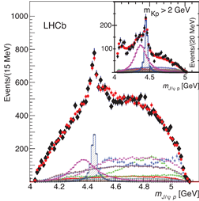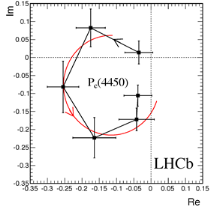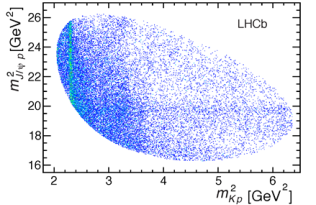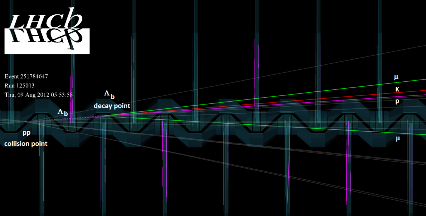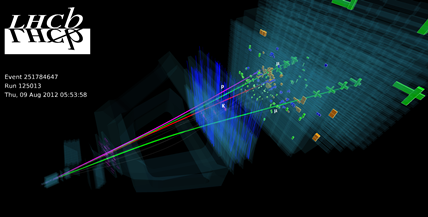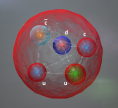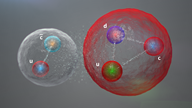[ m(Pc+(4450)) = 4449.8±1.7±2.5 MeV, Γ = 39±5±19 MeV ]
[ m(Pc+(4380)) = 4380±8±29 MeV, Γ = 205±18±86 MeV ]
The LHCb collaboration submitted today a paper based on run 1 data which reports the observation of pentaquark-charmonium states decaying into a J/ψ meson and a proton p. In the traditional quark model, the strongly interacting particles (hadrons) are formed either from quark-antiquark pairs (mesons) or three quarks (baryons). Particles which cannot be classified within this scheme are called exotic hadrons. In his fundamental 1964 paper, in which he proposed the quark model, Gell-Mann mentioned the possibility of adding a quark-antiquark pair to a minimal meson or baryon quark configuration. It has taken 50 years, however, for measurements to be performed that unambiguously demonstrate the existence of these exotics. In April 2014 the LHCb collaboration published results of measurements which demonstrated that the Z(4430)+ particle, first observed by the Belle collaboration, is composed of four quarks (ccdu). Today, the collaboration has announced the observation of a pentaquark, that is a hadron consisting of five quarks.
LHCb physicists have analyzed a sample of about 26 000 Λb0 → J/ψpK– decays with only 5% of background contamination. The Λb0 baryon is like a neutron, but containing a beauty quark in place of one of the down quarks. This decay can proceed by the diagram (a), which involves conventional hadrons and is dominated by Λ* resonances that decay in turn into a proton p and K– meson. It can also have exotic pentaquark contributions, shown in diagram (b), that result in resonant structures (called Pc+ in today’s paper) at 4380 and 4450 MeV in the J/ψp invariant mass spectrum shown in the left image below. The Pc+ particles decaying into a J/ψ meson and a proton must have a minimal quark content ccuud, and are therefore called pentaquark-charmonium.
Claimed discoveries of pentaquark states by other experiments in the past have turned out to be spurious. LHCb physicists have therefore performed a thorough analysis to demonstrate that the signals observed in their data cannot be produced by conventional hadrons, and that they have the properties expected from an exotic resonance, that is a short-lived particle lying outside the traditional quark-model.
LHCb physicists first tried to describe the data with conventional hadrons from the traditional quark model, including 14 Λ* resonances. As this did not give a satisfactory description of the data, they tried to add one Pc+ state, and when that was not sufficient they added a second state. The first one has a mass of 4449.8±1.7±2.5 MeV and a width of 39±5±19 MeV, while the second is wider, with a mass of 4380±8±29 MeV and a width of 205±18±86 MeV. The statistical significance of each of these resonances is more than 9 standard deviations. The J/ψp invariant mass spectrum from the data (below, left) is shown as solid (black) diamonds with error bars, while the solid (red) points show the results of the best data interpretation taking into account quantum mechanical description of Pc+ states formation in the presence of conventional Λ* resonances. The blue open circles with the shaded histogram represent the contribution of the Pc+(4450) state. The purple filled circles connected by the histogram represent the Pc+(4380) state. This wider state is clearly seen in the insert for which a more restricted range of the Kp invariant mass spectrum (above 2 GeV) was required. Each Λ* component is also shown in different colors.
In the final step of the analysis the LHCb physicists set out to prove that both Pc+ structures really possess the properties of a resonant particle, that is a quantum state with well-defined quantum numbers, which is produced, lives for some time, and then decays. The images above prove to experts that this is indeed the case. The central one shows the so called Argand diagram indicating that the Pc+(4450) structure seen in the data (black points) represents really the resonant particle production and decay, since it approximately follows a circular path (red circle), as is expected for a resonant particle. The right one shows the so called Dalitz plot in which a distinct horizontal band near 19.5 GeV2 in the J/ψp invariant mass squared indicates the resonant Pc+(4450) and Pc+(4380) contributions. The analysis of angular distributions of the decay products leads to the most probable assignment of the two Pc+ quantum numbers JP to be 3/2– and 5/2+ although two other combinations are possible.
A typical Λb0 → J/ψpK– decay is shown above. The Λb is produced in the pp collision point, the origin of many particle tracks, and decays at a distance of 3.9 cm into a J/ψ meson, a K meson and a proton p. The J/ψ meson decays in turn into a μ+ and μ– pair. The kaon K and the proton p particles traverse the LHCb detector and are absorbed in the hadronic calorimeter. The two muons (μ) leave the calorimeter system and traverse the whole muon detector system. The event can also be seen in the top view as well as in the front view of the Λb decay point region.
A new field of research now opens up. Scientists will try to understand the “internal mechanism” of quark interactions inside pentaquarks. The two possibilities are illustrated in the figure. The color of the central part of each quark is related to the strong interaction color charge, while the external part shows its electric charge. The quarks could be tightly bound, or they could also be loosely bound in meson-baryon molecule, in which color-neutral meson and baryon feel a residual strong force similar to the one that binds nucleons together within nuclei. It is hoped that future measurements by LHCb will help to answer this question.
Click the images for higher resolution. Read more in the LHCb publication in arXive and in PRL, in the CERN Press Release in English and French, in the CERN Courier article, in the Nature news, in the APS Viewpoint, in the Symmetry magazine, in the Quantum Diaries blog and in different media articles. See also the Fermilab video explaining the LHCb observation and the Gell-Mann’s comment.
Added in August 2016: see APS Synopsis, “Pentaquark Discovery Confirmed”, and two papers showing that the evidence for pentaquarks in the discovery data is model independent and that the analysis of the Λb0 → J/ψpπ– decays confirmes observation of the two pentaquark particles.


